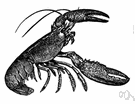The digestive proteases of the American lobster (
Homarus americanus) and the Japanese spiny lobster (Panulirus japonicus), presents an optimal pH range of 7 to 8 (Brockerhoff et al., 1970; Galgani & Nagayama, 1987), while the maximum digestive enzymatic activity of the multienzymatic extracts of M.
Lobster trap video: in situ video surveillance of the behavior of
Homarus americanus in and around traps.
The blue crab (Callinectes sapidus Rathbun, 1896) and the American lobster (
Homarus americanus Milne-Edwards, 1837) are omnivores and include both algae and vascular plants in their diets (Ennis 1973, Scarratt 1980, Elner & Campbell 1987, Rosas et al.
After hatching, American lobsters
Homarus americanus likely first come into contact with shelter during the late postlarval (decapodid) stage, known as stage IV.
Florida's spiny lobsters have a unique flavor, generally a bit stronger than the large-clawed northern lobster (
Homarus americanus, American lobster), and one that doesn't need to be enhanced with gooey sauces.
The American lobster,
Homarus americanus (Milne-Edwards) supports is a multi-billion dollar fishery in Atlantic Canada and New England.
Effects of crude oils on the feeding behavior of lobster
Homarus americanus. Environmental Pollution, 6: 77-86.
Interestingly, research has shown that some species are able to recognize individuals that they have encountered in the recent past such as two species of hermit crabs [46-48], crab [49], mantis shrimp Gonodactylus festae [50, 51], lobsters
Homarus americanus [52], and crayfish [53].
With: Brian Jannelle Adrian Guillette, Arthur Smith, Asterias Vulgaris, Callinectes Sapidus, Christopher Swampstead, Cleona Celata, Clyde Lee, Declan Conneely, Fulmaris Glacialis, Gadus Morhua, Hippoglossus Hippoglossus,
Homarus Americanus, Johnny Gatcombe, Larus Marinus, Larus Argentatus Smithonianus.
 Homarus americanus - lobster of Atlantic coast of America
Homarus americanus - lobster of Atlantic coast of America